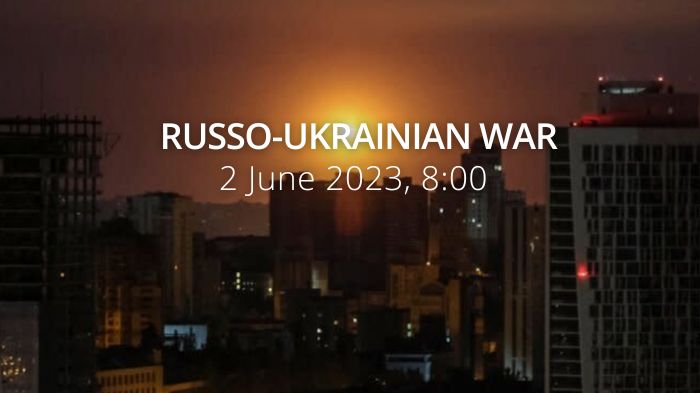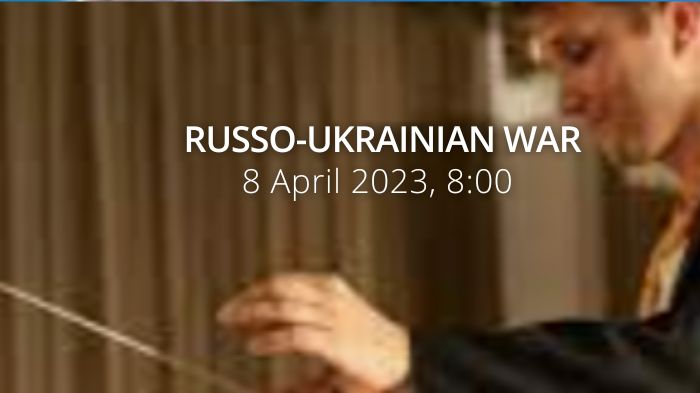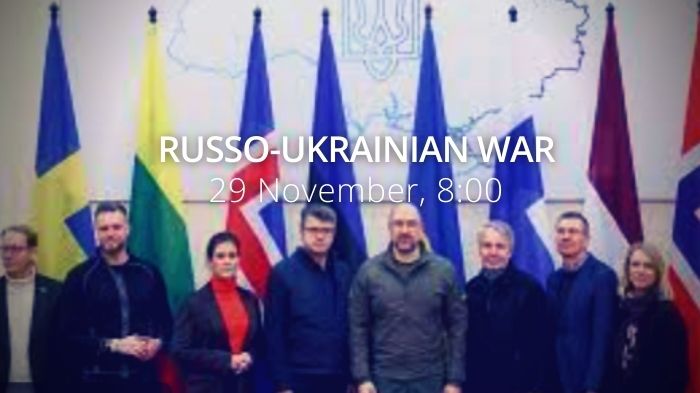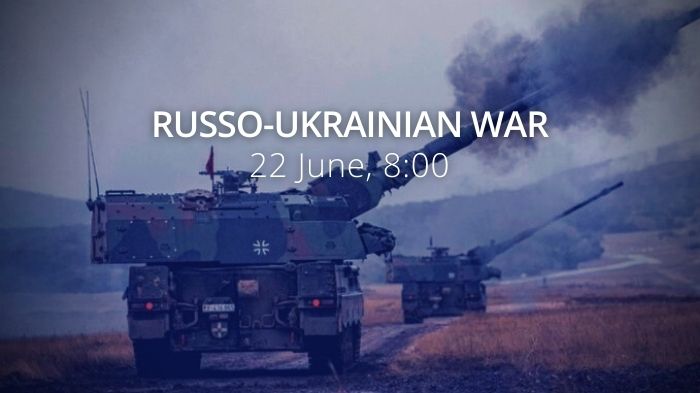Russia launches another series of missile strikes on Ukraine overnight on May 31 to June 1 and during the day on June 1. Russia spent up to US$17 million on the attack on Kyiv. Russian Volunteer Corps (RDK) and Freedom of Russia Legion (LSR) conducted another raid into Belgorod Oblast.
Daily overview — Summary report, June 3
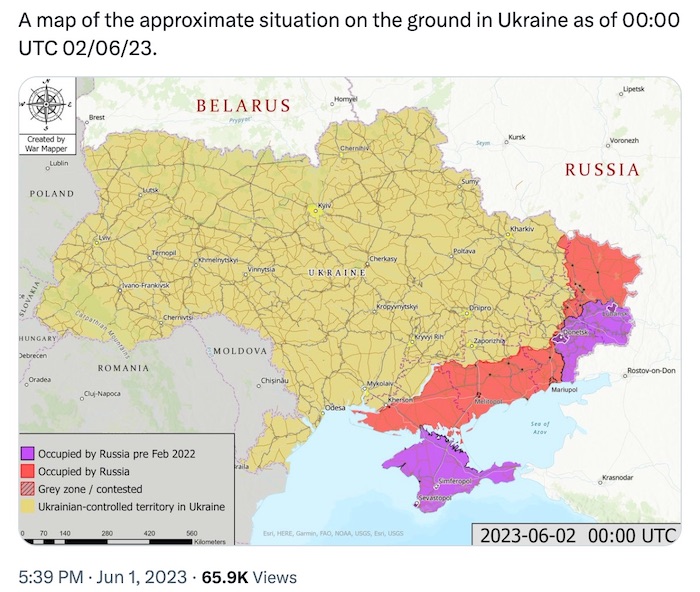
The General Staff’s operational update regarding the Russian invasion as of 18.00 pm, June 3, 2023 is in the dropdown menu below:
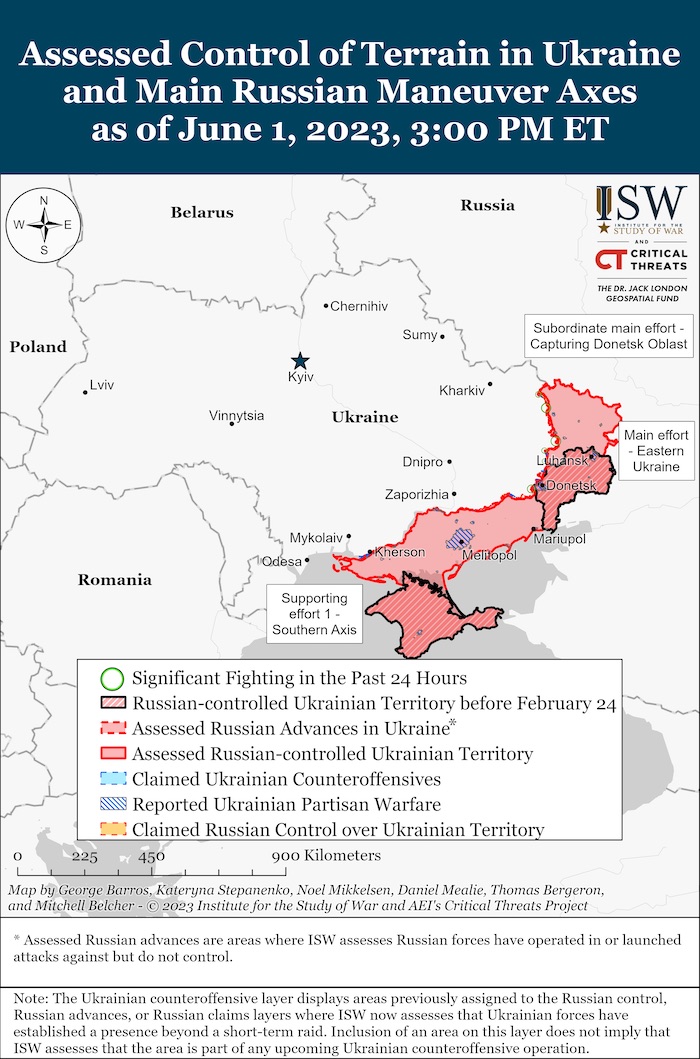
The Russian Federation has been suffering heavy losses as it continues to use terror tactics to intimidate the Ukrainians.
Preliminary information: last night, the enemy used 15 cruise missiles (the type to be specified) and 18 Iranian Shahed combat UAVs to attack Ukraine, with all of these air threats intercepted by our defenders. The information is being updated.
On June 1, the enemy launched 12 missile attacks using 10 Iskander ballistic and cruise missiles (intercepted by Ukrainian defenders) and 2 S-300 anti-aircraft guided missiles on Kyiv. In addition, the invaders launched 46 airstrikes and 107 MLRS attacks at the positions of Ukrainian troops and various settlements. Unfortunately, the attacks have killed and wounded civilians, including children. Also, a children’s clinic, apartment buildings, private houses, and other civilian infrastructure have been damaged.
The likelihood of missile and air strikes across Ukraine remains high.
The enemy continues to focus its main efforts on attempts to fully occupy Luhansk and Donetsk oblasts. On June 1, Ukrainian Defense Forces repelled 25 enemy attacks.
- Volyn and Polissya axes: no changes or signs of the formation of offensive groups were found.
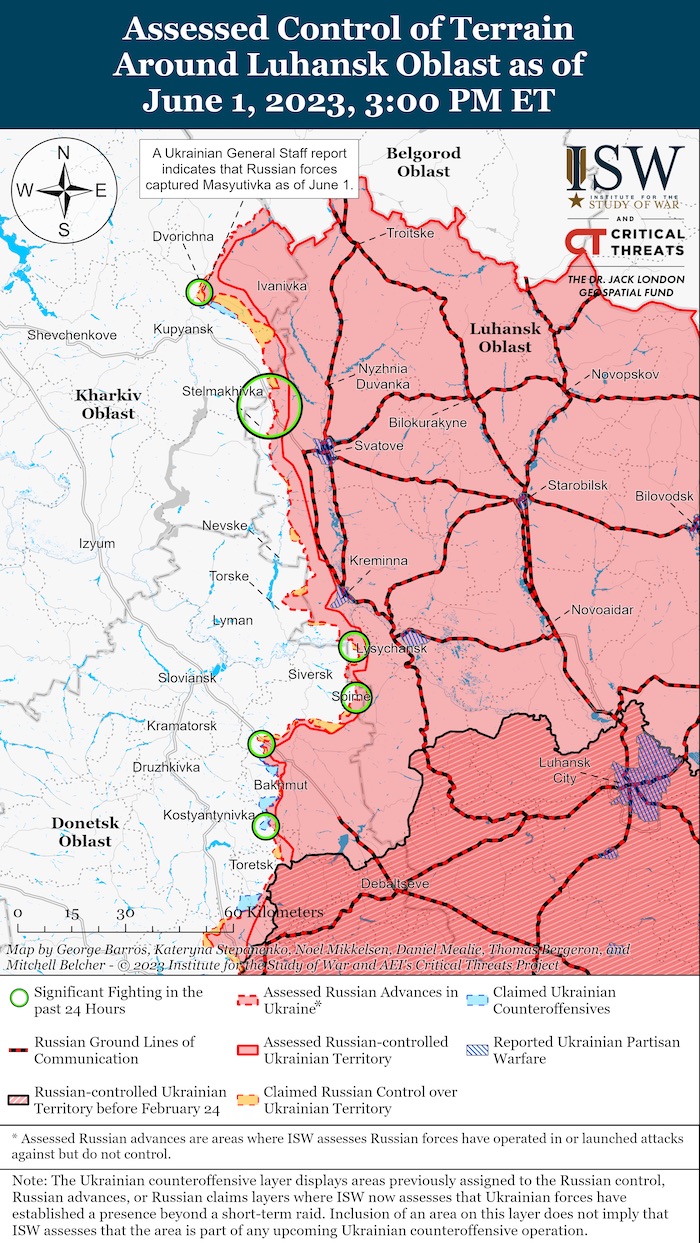
- Sivershchyna and Slobozhanshchyna axes: the adversary continues to maintain a military presence in the areas of Russia bordering Ukraine. Russian forces launched an airstrike in the vicinity of Halahanivka (Chernihiv oblast). The invaders fired mortars and artillery at the settlements of Berylivka, Yeline, Mistky, Khotiivka, Tymonovychi, Yanzhulivka, Krasnyi Khutir, Mykolaivka (Chernihiv oblast), Seredyna-Buda, Atyns’ke, Pavlivka, Pysarivka, Uhroidy, Krasnopillya, Slavhorod (Sumy oblast), Udy, Kozacha Lopan’, Hoptivka, Ohirtseve, Hatyshche, Buhruvatka, Vovchans’k, Mala Vovcha, Varvarivka, Budarky, Chuhunivka (Kharkiv oblast).
- Kupiansk axis: the adversary conducted unsuccessful offensives west of Masyutivka (Kharkiv oblast), and Kuzemivka (Luhansk oblast) on June 1. The invaders launched airstrikes in the vicinities of Vil’shana, Kotlyarivka, Krokhmal’ne (Kharkiv oblast), and Serhiivka (Luhansk oblast). The adversary fired artillery and mortars at Fyholivka, Novomlyns’k, Dvorichna, Masyutivka, Lyman Pershyi, Kyslivka, Berestove (Kharkiv oblast), and Novoselivs’ke (Luhansk oblast).
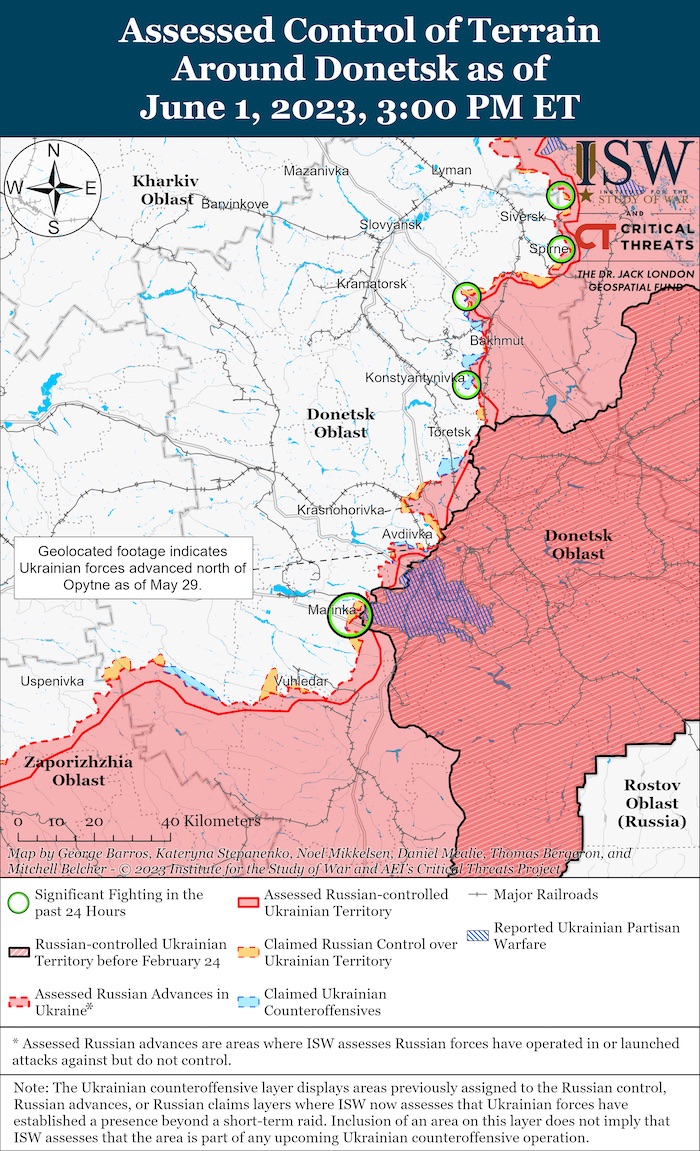
- Lyman axis: On June 1, the adversary conducted unsuccessful offensives in the vicinity of Bilohorivka (Luhansk Oblast) and Spirne (Donetsk Oblast). The invaders launched airstrikes in the vicinities of Bilohorivka (Luhansk Oblast), Yampolivka, Sivers’k, and Spirne (Donetsk Oblast). Nevske, Bilohorivka (Luhansk oblast), Novosadove, Tors’ke, Spirne, and Mykolaivka (Donetsk oblast) came under artillery fire.
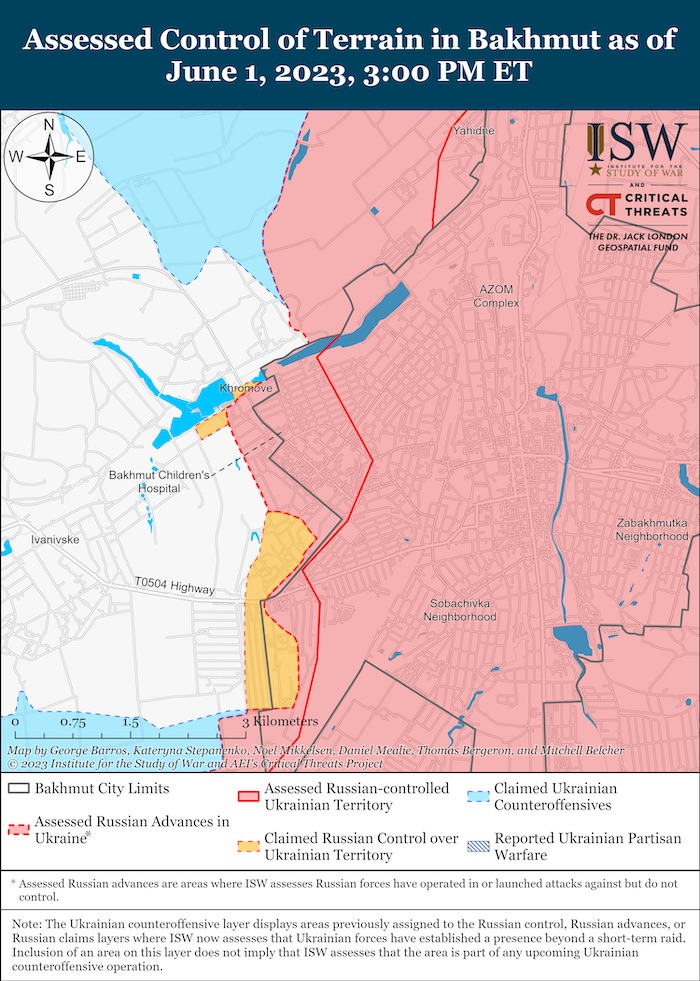
- Bakhmut axis, the adversary launched airstrikes in the vicinities of Khromove, Bila Hora, and Oleksandro-Shul’tyne (Donetsk oblast) on June 1. Kramatorsk, Vasyukivka, Orikhovo-Vasylivka, Novomarkove, Hryhorivka, Chasiv Yar, Ivanivske, Predtechyne, Bila Hora, Dyliivka, Zalizne, and New York (Donetsk oblast) suffered from enemy artillery shelling.
- Avdiivka axis: the adversary did not conduct any offensive The invaders launched airstrikes in the vicinities Avdiivka and Vodyane (Donetsk oblast). The occupant forces fired artillery at the settlements of Avdiivka, Vodyane, Pervomais’ke, and Karlivka (Donetsk oblast).
- Marinka axis: Ukrainian defenders repelled all enemy attacks in the vicinity of the city of Marinka. The enemy also launched an airstrike there and fired artillery at Heorhiivka, Mar’inka, Pobjeda, and Novomykhailivka (Donetsk oblast).
- Shakhtarske axis: the enemy launched airstrikes in the vicinities of Vuhledar, Prechystivka, and Velyka Novosilka (Donetsk oblast). The invaders shelled the settlements of Vuhledar, Prechystivka, and Novoukrainka.

- Zaporizhzhia and Kherson axes: the adversary stays on the defensive. The occupant forces launched airstrikes in the vicinities of Robotyne (Zaporizhzhia oblast), Beryslav, Kozats’ke, and Odradokam’yanka (Kherson oblast). The invaders shelled the settlements of Illinka, Velyka Novosilka, Vremivka, Zelene Pole (Donetsk oblast), Malynivka, Hulyaipole, Zaliznychne, Huliaipilske, Bilohir’ya, Mala Tokmachka, Novoandriivka (Zaporizhzhia oblast), Marhanets’, Nikopol’ (Dnipropetrovsk oblast), Zmiivka, Vesele, Ivanivka, Inhulets’, Sadove, Antonivka, Zelenivka, Dniprovs’ke, Kizomys (Kherson oblast), and the city of Kherson.
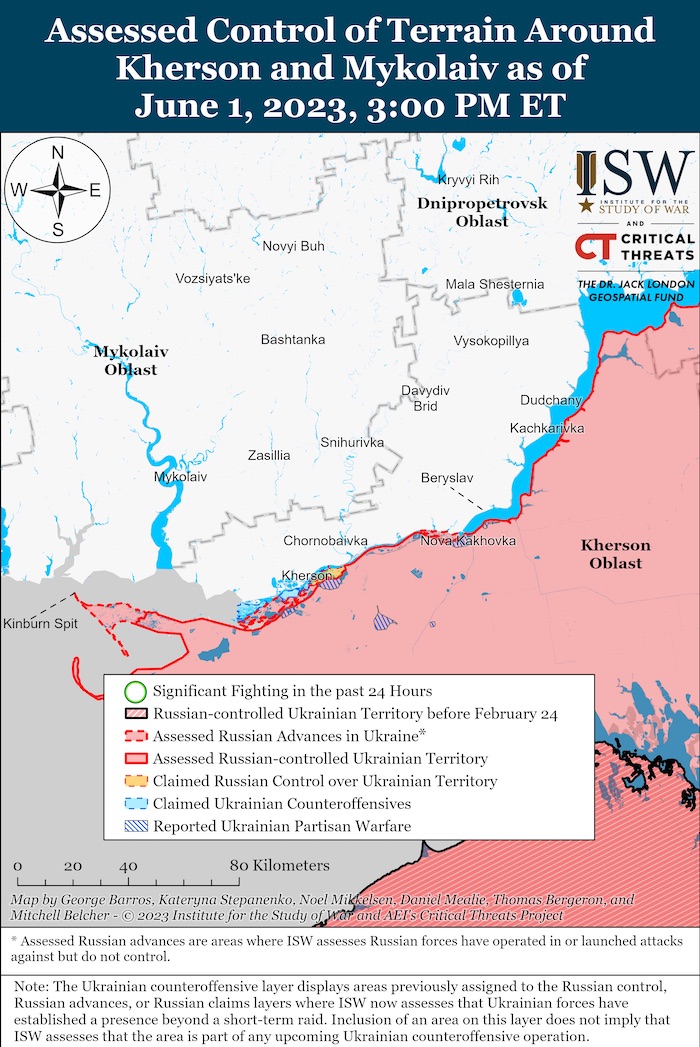
The Russian occupiers continue to force Russian passports on the residents of the temporarily occupied territory of Kherson oblast. In particular, the Russian occupation administration has set September 1, 2023, as the deadline for obtaining a Russian passport and a mandatory written refusal of a Ukrainian passport. Also, local energy companies report that it is mandatory to re-sign new electricity supply contracts, which is only possible for holders of a Russian passport. All Ukrainian citizens refusing to receive the Russian IDs are threatened with the termination of electricity supply, deportation, confiscation of property, and forced eviction from their homes.
[Russian occupation forces continue to suffer heavy losses on the battlefield. As a result, the enemy continues to turn civilian facilities in the temporarily occupied territories into medical facilities. For example, in Melitopol, Zaporizhzhia Oblast, the occupiers turned a children's sanatorium into a military hospital, where more than 200 Russian soldiers with injuries of varying degrees of severity are being treated. Also, Russian terrorists, disregarding the laws of international humanitarian law, placed a base of Russian military personnel with military equipment on the territory of the Melitopol Alexander Nevsky Cathedral.]
On June 1, the Ukrainian Air Force launched 9 air strikes on the concentrations of troops and military equipment, as well as 4x air strikes on the anti-aircraft missile systems of the adversary.
The Ukrainian Defense Forces destroyed 2 Lancet combat UAVs and 1 Orlan-10 reconnaissance UAV.
On June 1, the Ukrainian missile and artillery troops hit 1 command post, 1 anti-aircraft missile system, 5 artillery units at their firing positions, and 9 concentrations of enemy weapons and military equipment.
This is only a temporary lull, the format of the operation changed – Ukraine's Ground Forces Commander on Bakhmut, Ukrainska Pravda reports. “Oleksandr Syrskyi, Commander of the Ukrainian Ground Forces, has stated that Russia changed the operation format on the Bakhmut front, so there is a temporary lull.
The situation on the Bakhmut front has changed. There is a significant decline in any active hostile actions with an increase in the number of attacks from heavy weapons, mainly artillery and mortars. At first glance, it seems the enemy has given up on further offensive actions in this area, but this image is not true. The format of the operation has temporarily changed, with the withdrawal of Wagner units and their replacement by the [regular] army and air assault units. Therefore, the current situation may appear to be calm. However, unfortunately, it is only a temporary lull.
Syrskyi stressed that Russia seeks to seize the initiative to prevent Ukrainian counterattacks and go on the offensive. In addition, he said that the Ukrainian Armed Forces suspended their advance on the flanks on the Bakhmut front over the past few days.”
Armed Forces of Ukraine suspended advance on flanks, other tasks performed – Ukraine's Ground Forces Commander on situation in Bakhmut, Ukrainska Pravda reports, citing Oleksandr Syrskyi, Commander of the Ground Forces of the Armed Forces of Ukraine. “The Armed Forces of Ukraine have suspended their advance on the flanks on the Bakhmut front over the past few days.
Over the past few days, the advance on the flanks was suspended, as other essential tasks were performed there. The command of our group is taking appropriate measures aimed at restoring the combat capability of our units and disrupting Russian intentions (namely, do not allow Ukrainian counter-offensive actions to happen, instead switching to the offensive themselves – ed.)”
Ukrainian air defences shoot down over 30 missiles, drones fired at Kyiv overnight on 2 June, Ukrinform reports, citing the Kyiv city military administration reported this on Telegram. “Ukraine's air defence forces have shot down more than 30 missiles and drones in the airspace over and around Kyiv overnight. The terror of Kyiv with air attacks continues. Desperate terrorists attack the capital almost nonstop. In the last six days, the rashists have already carried out the sixth airstrike against the city! And every time the enemy changed weapons, said Serhii Popko, head of the city military administration.
According to him, this time the attack was combined, with Russia using drones and cruise missiles at the same time. Tu-95MS strategic bombers likely fired Kh-101/155 cruise missiles from the area of the Caspian Sea. At the same time, drones, likely Shahed loitering munitions, attacked Kyiv from different directions.”
10 missiles were destroyed during the night of 1 June: 7 "Iskander-M" and 3 "Iskander-K", Ukrainian General Staff reports. “Around 2:45 a.m. on June 1, 2023, the Russian occupiers continued a series of attacks on the capital of Ukraine, the city of Kyiv. Again, the enemy sneakily attacks with land-based ballistic and cruise missiles from the operational-tactical missile system Iskander. As a consequence, there is not much time to seek shelter.
A total of 10 ballistic and cruise missiles of the "Iskander" type were launched from the northern direction - the Bryansk region of the Russian Federation.
All 10 were destroyed by the air defence forces and means of the Air Force of the Armed Forces of Ukraine: seven Iskander-M ballistic missiles and three Iskander-K cruise missiles.
Unfortunately, as a result of the anti-aircraft battle, there are dead and wounded, among them – children.”
Russia spent up to US$17 million on last night's attack on Kyiv, Ukrainska Pravda reports, citing Military Media Center, a media platform for the Ukrainian Defence Forces created by the Ministry of Defence. “Russia fired seven Iskander-M ballistic missiles and three Iskander-K cruise missiles on Kyiv on the night of 31 May-1 June, all of which were shot down by Ukrainian air defence. One Iskander-M missile, according to media reports, costs up to US$2 million, while an Iskander-K missile costs up to US$1 million. Thus, the Russian invaders spent up to US$17 million on just one night’s attack on the capital.”
Russian Volunteer Corps and Freedom of Russia Legion announce breaking into Russia again, Ukrainska Pravda reports, citing the Russian Volunteer Corps; Freedom of Russia Legion. “On 1 June 2023, the Russian Volunteer Corps and Freedom of Russia Legion announced that they were conducting another operation on the territory of the Russian Federation. The fighters recorded a video message and reported they were going toward Shebekino. In particular, a man in a military uniform says in the video that the neighbourhood of Shebekino will appear very soon.
The fighters claim that they plan to liberate all of Russia from Putin's regime. The Freedom of Russia Legion also announced a raid on the territory of the Russian Federation: We, the Freedom of Russia Legion, are now near the border of our homeland, very soon we will advance again on the territory of Russia to bring freedom, peace, and tranquillity. Graivoron is only the beginning. Locals are asked not to leave buildings and to remain calm.
The Russian authorities report on shelling and fighting, which allegedly lasted all night, but they assure the locals that there is no breakthrough of the Armed Forces [of Ukraine].
Military Updates
According to British Defence Intelligence, (last 48 hours):
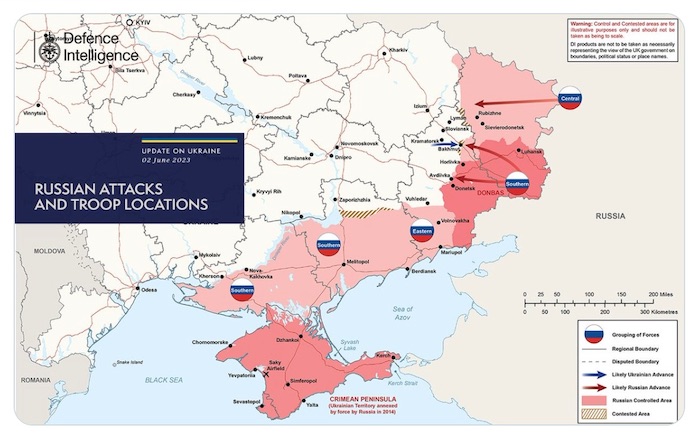
- From the morning of 01 June, partisan groups attacked Russia’s Belgorod region for the second time in ten days. In a complex battlefield situation, what appeared to be uncrewed aerial vehicles also struck Belgorod city (35km inside Russia), while the authorities evacuated civilians from the border town of Shebikino following Ukrainian shelling.
- The Russian military and interior forces have likely seen quicker success in containing this raid than the previous one. However, according to the Russia MOD’s own press release, it has resorted to deploying the full range of military firepower on its own territory, including attack helicopters, and the TOS-1A heavy thermobaric rocket launcher.
- Russian commanders now face an acute dilemma of whether to strength defences in Russia’s border regions or reinforce their lines in occupied Ukraine.
- On 27 May 2023, Russian opposition politician Boris Nadezhdin appeared on Russia’s NTV channel and called for a new president to be elected in 2024, in order to rebuild normal relations with Europe.
- Nadezhdin has been a vocal critic of the war since the invasion, but this is highly likely the first call for Putin to be replaced on Russian state-approved TV since it began.
- In the last 15 months, Russia has introduced limitations on freedom of speech which haven’t been seen since Soviet times. However, there is a realistic possibility that recent vitriolic rhetoric by nationalist figures such as Wagner Group owner Yevgeny Prigozhin is emboldening opposition figures to challenge taboo topics.
Losses of the Russian army
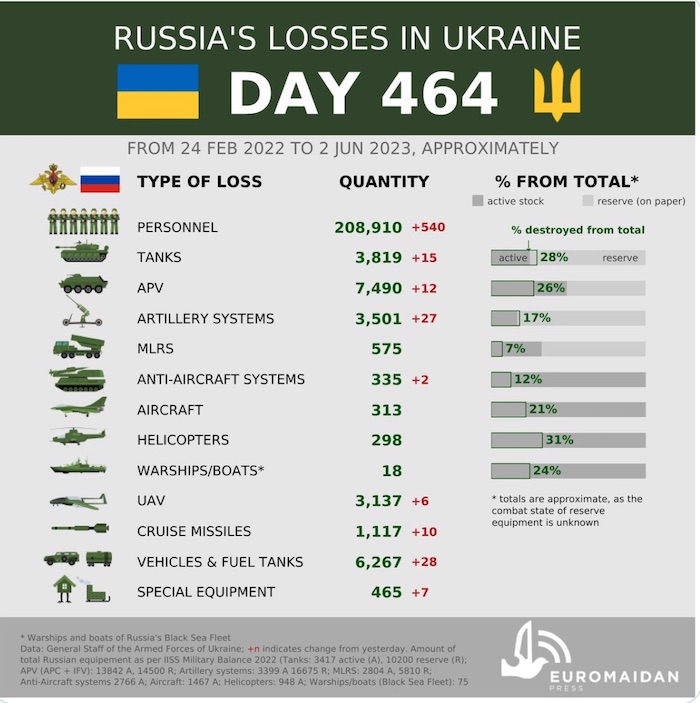
As of Friday 2 June, the approximate losses of weapons and military equipment of the Russian Armed Forces from the beginning of the invasion to the present day:
- Personnel – about 208910 (+540)
- Tanks – 3819 (+15)
- Armoured combat vehicles – 7490 (+12)
- Artillery systems – 3501 (+27)
- Multiple rocket launchers –MLRS - 575 (+0)
- Air defence means – 335 (+2))
- Aircraft - 313 (+0)
- Helicopters - 298 (+0)
- Automotive technology and fuel tanks – 6267 (+28)
- Vessels/boats - 18 (+0)
- UAV operational and tactical level – 3137 (+6)
- Special equipment – 465 (+7)
- Mobile SRBM system – 4 (+0)
- Cruise missiles – 1117 (+10)
The capture of Bakhmut cost Russia 60,000 killed and wounded – Western estimates, Ukrainska Pravda reports, citing Sky News. “We judge that capturing Bakhmut has likely cost Russia at least 60,000 casualties in that Bakhmut-Popasna sector over the course of the year-long battle, the official said. He clarified that 60,000 is a conservative estimate of Russian losses in this area of the contact line, which includes both the wounded and the killed. Of these, the official added, at least a third were killed. […]
We are seeing Wagner [mercenary] forces in the process of withdrawing, at least for now. Replacing these force elements is a significant commitment of Russia's already overstretched regular forces, the official said.”
Russia’s Month of Missile Madness: 90% of Projectiles Failed, $1.7 Billion Spent, Kyiv Post reports. “Kyiv Post analyzed Ukraine air force data on Russia’s May missile campaign which shows that although on a huge scale was highly ineffective, costly and wasteful. Russia fired more than 500 missiles and kamikaze drones at Ukraine during May with nearly 90 percent of them being destroyed by Ukrainian air defences, a Kyiv Post analysis of Ukrainian military data has revealed, at a cost to the Russians of more than $1.7 billion dollars.
After conducting a day-by-day analysis of information released by Ukraine’s Air Force, Kyiv Post identified that at least 563 missiles of various categories and Iranian-made Shahed drones that were fired against Ukrainian settlements and territories from the beginning to the end of May. Of those, 533 were destroyed by Ukrainian air defence systems which is a neutralization rate of over 90 percent for the month – during which there were some 20 combined Russian aerial attacks with most including Kyiv.
The attacks on Ukraine included 401 Shahed-136 UAVs (unmanned aerial vehicles) which Russia weaponizes as Geran-2’s for one-way missions. Ukrainian air defences destroyed 362 of the incoming drones or, again, over 90 percent of them. Each Shahed costs around $20,000 so the minimum cost to Russia of their deployment would have been around $ 8 million in May alone. Russia may have purchased some 2400 overall Shaheds from Iran, according to the Ukrainian government, but some estimates are lower.
Also used in the attacks, which are conducted from bombers, airfield launch facilities, and ships, were: Kh101-555 missiles - 114 deployed; 106 destroyed; a 93 percent neutralization rate; potential cost; $1.48 billion. […]
To scale the cost of Russian attacks - over $1.7 billion in one month - the Kyiv School of Economics has recently estimated that the total reconstruction cost for Ukraine's health sector is around $1.7 billion.
May 27/28 was the date with the single most attacking Shaheds when 54 were deployed and 96.3 percent were destroyed. May 28/29 could be called the most intense day of Russian attacks with a combination of 86 missiles and drones deployed against Ukraine; 89.5 percent of incoming were destroyed.
Kyiv Post notes that, while there are some inconsistencies in how air defence data was disclosed that may have impacted on exact figures given in our analysis; we have made conservative assumptions where it was necessary. The data is that which is made public by the Ukrainian armed forces and was not subject to independent verification. Even so – the trend and the levels of failure by Russia is self-evident.”
Looks "reliable": cracks appeared on pillars of the Crimean bridge, Censor.net reports, citing Activist Serhiy Sternenko drew attention to this on his Telegram channel. “Two vertical cracks have appeared on two pillars of the Crimean Bridge. They cover the entire length of the pillars. Crimean bridge. “Looks reliable," he wrote and posted the relevant photos.”
Humanitarian
The forced evacuation of children was announced in 7 settlements in Donetsk Oblast, Ukrainska Pravda reports. “The forced evacuation of 239 children to safer regions of Ukraine has been announced in seven settlements in Donetsk Oblast. The forced evacuation of children will be carried out in the city of Zalizne, the villages of New-York and Pivnichne, and the villages of Kostiantynivka, Ivanopillia, Mykolaivka, and Podilske.
The relevant decision was made by the Donetsk Oblast Military Administration because the security situation in the region "remains critical", reports the Ministry of Reintegration.”
Ukrainian grain critically important for saving millions of children from hunger – Kyslytsya, Ukrinform reports. “For many years, the UN World Food Programme has been using Ukrainian grain to save the population of the most vulnerable countries, including millions of children, from hunger. At the same time, we see that Russia cynically continues to use hunger as a weapon, blocking Ukrainian seaports, destroying agricultural infrastructure, and contaminating agricultural lands with mines, Sergiy Kyslytsya, Permanent Representative of Ukraine to the UN, told Ukrinform in a comment.
According to him, in countries where conflicts have been going on for many years – Yemen, Somalia, Afghanistan, and Syria – the main thing to protect children is to solve the problem of hunger. In particular, 43,000 people, half of them children, died of hunger in Somalia last year as a result of the drought. Another 18,000 may die within six months if appropriate international aid is not provided. In total, about 1.8 million children under the age of five suffer from acute malnutrition in this country.
In Yemen, 2.2 million children are severely malnourished, and over 540,000 are starving. In total, during the conflict, which has been ongoing since 2015, more than 11,000 children have been killed or maimed there.
More than 35,000 children have been killed and maimed in Afghanistan during the conflict that has been ongoing since 2001. After the Taliban seized power in August 2021, the situation of children worsened significantly. Today, according to UNICEF estimates, 100% of children in the country, numbering almost 13 million, need humanitarian assistance. At the same time, hunger is the cause of 45% of child deaths. 212 children die there every day due to the unavailability of basic medical care.
I cited these terrible numbers in order to show the critical importance of the grain initiative, which is actively championed by UN Secretary-General António Guterres, Kyslytsya explained. As reported, on May 17, the "grain agreement" was extended for two months, until July 18. However, Russia said last week that if its demands for increased grain and fertilizer exports were not met, it would not extend the deal further. Moscow made the same threat in March.”
UN tries to save Black Sea grain deal with 'mutually beneficial' proposal, Reuters reports. “The UN has proposed that Kyiv, Moscow and Ankara start preparatory work for the transit of Russian ammonia through Ukraine as it tries to salvage a deal allowing safe Black Sea grain exports, a source close to the talks said on Wednesday. As the preparatory work starts, the UN wants parallel talks to be held on widening the Black Sea deal that was agreed last July to include more Ukrainian ports and other cargoes, said the source, who spoke to Reuters on condition of anonymity.
Russia agreed this month to a two-month extension of the deal but has said the initiative will cease unless an agreement aimed at overcoming obstacles to Russian grain and fertiliser exports is fulfilled.
Ukraine and Türkiye have agreed to the new proposal, intended to improve operations in the Black Sea grain export corridor, but Russia has not yet responded, the source said.”
Legal
Ukraine's High Council of Justice elected new High Qualification of Judges, one of requirements on "EU membership list", Ukrainska Pravda reports, citing the High Council of Justice. “On 1 June, the High Council of Justice appointed all members of the new High Qualification Commission of Judges (HQCJ), which was one of the tasks received by Ukraine along with the status of a candidate for EU membership. Based on the results of interviews with 32 candidates recommended by the Selection Commission HQCJ, the High Council of Justice appointed 16 members of the Commission, 8 of whom were appointed from among judges and retired judges.
The communique notes that unlocking the work of the HQCJ will allow for recruitment of judges on more than 2,000 vacant positions, and to complete the qualification evaluation of judges.
The DEJURE Foundation, an expert organisation specialising in judicial reform monitoring, congratulated the election of the new High Court of Justice and called the event "an unequivocal victory", but also noted that there is a lack of "agents of change" among the new members, in particular, there is not a single representative of specialised non-governmental organisations. […]”
Support
Pistorius on the transfer of Taurus long-range missiles to Ukraine: We are very reserved in this position, Censor.net reports, citing German Defense Minister Boris Pistorius, with reference to the Euro Integration. "We are very reserved, I made it clear before. Nothing has changed in this position so far, he said. According to Pistorius, a decision on this issue has not yet been made.
The Taurus KEPD 350 long-range subsonic cruise missile is designed for high-precision hitting of protected targets at a range of up to 500 km. The rocket weighing 1,400 kg and 5 meters long was developed by Taurus Systems GmbH, a joint venture between MBDA Deutschland and the Swedish company Saab Bofors Dynamics AB.
Earlier, the German opposition advocated the transfer of long-range Taurus missiles to Ukraine. According to the media, Ukraine has officially requested Taurus cruise missiles from Germany.”
Germany hands over another military aid package to Ukraine, Ukrinform reports. “The German government announced another batch of military equipment transferred to Ukraine. The list has been updated on the website of the Federal Government of Germany, Ukrinform reports.
Germany has already delivered ammunition for Leopard 1 tanks and two 8x8 HX81 trucks. In addition, the German authorities handed over seven tracked and remote controlled infantry vehicles THeMIS to Ukraine. It is noted that the German government soon plans to transfer 64 tracked all-terrain vehicles Bandvagn 206 and 66 armoured personnel carriers to Ukraine.”
Pentagon signed a contract for the supply of Starlink terminals to Ukraine, Ukrainska Pravda reports, citing Bloomberg. “The US Department of Defence has signed a contract with billionaire Elon Musk's SpaceX company to purchase Starlink satellite communication terminals for Ukraine and services for use by the Ukrainian military.
The Pentagon statement notes that satellite communication is a vital layer in Ukraine’s overall communications network and the department contracts with Starlink for services of this type.”
Pentagon to buy Gepard systems for Ukraine worth almost $120M, Ukrinform reports. “Global Military Products Inc, Tampa, Florida, was awarded an $118,375,740 firm-fixed-price contract for the purchase and delivery of Gepard 35 mm air defence systems, reads the press release published on the website of the US Department of Defense.
Work will be performed in Amman, Jordan, with an estimated completion date of May 30, 2024. The relevant funds were allocated under the Foreign Military Sales (Ukraine Security Assistance Initiative).”
The Netherlands want to procure dozens of Leopard 1 tanks for Ukraine, Ukrainska Pravda reports, citing the television and radio company NOS. “The Dutch government plans to purchase dozens of Leopard 1 tanks for delivery to Ukraine. A Swiss company may become the supplier of tanks, sources in The Hague said.
The purchase of tanks still requires the permission of the Swiss government, and they want to stay away from war with Russia as much as possible. The supply of weapons puts neutrality at risk, as the Swiss said earlier. So the agreement on the purchase of tanks has not yet been concluded.”
European Commission working on a four-year financing plan for Ukraine – FT, Ukrinform reports, citing Financial Times. “The European Commission is working on a four-year multi-billion financing plan for Ukraine. According to EU diplomats and officials, the European Commission has started to work on a proposal that will help cover the country's needs until 2027.
The plan is also aimed at encouraging other allies, such as the US and UK, to provide similar long-term pledges to Ukraine. [Norway is launching EUR 7B five-year defence aid program for Ukraine] The proposals are still being drafted, but they could be ready as soon as this month, potentially ahead of the Ukraine Recovery Conference due to be held in London on June 21-22.”
New Developments
- Putin's press secretary says attacks on Belgorod Oblast have no impact on war with Ukraine, citing Ukrainska Pravda reports, citing RIA Novosti. “Dmitry Peskov, the spokesman of Russian President Vladimir Putin, has said that attacks on Belgorod Oblast have no impact on the so-called "special operation", as Russia calls the war against Ukraine. Peskov has stated that the situation with the attacks on Belgorod Oblast cannot affect the course of the "special operation" in general. On 1 June 2023, the Russian Volunteer Corps and Freedom of Russia Legion announced that they were conducting another operation on the territory of the Russian Federation. The fighters recorded a video message and reported they were going toward Shebekino.”
- European Parliament approves plan to increase ammunition production, Ukrinform “Members of the European Parliament have backed the Act in Support of Ammunition Production (ASAP) to increase the capabilities of the European defense industry, including for the supply of ammunition to Ukraine. According to the press serviceof the European Parliament, the legislation was adopted with 446 votes to 67, with 112 abstentions. MEPs will now start negotiations with the EU Council, with the aim of reaching a political agreement, which MEPs would then vote on in plenary in July.”
- Ukraine is ready to join NATO. We are waiting for Alliance to be ready to accept it, - Zelensky, net reports, citing President of Ukraine Volodymyr and RBC-Ukraine. “"Ukraine is ready to join NATO, we are waiting for NATO to be ready to accept Ukraine. Security guarantees are important not only for Ukraine but also for our neighbors - for Moldova due to Russia's aggression, Zelensky said at the first press conference after arriving at the summit of the European Political Community.”
- There are good informal discussions on Ukraine's steps towards NATO membership – NATO Secretary General, Ukrainska Pravda reports, citing Stoltenberg during the meeting of NATO members’ foreign ministers in Oslo. “Asked whether the Allies would agree on any specific steps for Ukraine to take to achieve NATO membership, the Secretary General replied: I am confident that we will find consensus on this issue. We already have good informal discussions. And we confirm the main point: Ukraine will become a member of this Alliance. Stoltenberg also pointed out that Ukraine has been moving towards NATO, shifting from Soviet to NATO standards.”
- Ukraine's membership in NATO is currently impossible – German Foreign Minister, Ukrainska Pravda “The Federal Minister for Foreign Affairs of Germany, Annalena Berbock, stated that at the moment there is no question of Ukraine's membership in NATO, as Russia's aggressive war continues. According to the head of the Ministry of Foreign Affairs of Germany, the doors of the Alliance are open for new members. This applies primarily to Sweden, but also to Ukraine. At the same time, it is also clear that we cannot talk about new membership in the midst of war, Baerbock said, commenting on Ukraine's accession. Upon arriving at the summit of the European Political Community in Moldova, Latvian Prime Minister Krišjānis Kariņš said that the possibility of Ukraine's membership in the Alliance after the war with Russia ends will be discussed at the NATO summit in Vilnius in July. Dutch Prime Minister Mark Rutte also noted that NATO will not be able to offer full membership to Ukraine at the summit in July due to Russia's war of aggression.”
- Macron says Ukraine needs clear, strong security guarantees at NATO summit, Reuters "Vilnius must send a clear message to Ukraine and Ukrainians. I favour stronger, concrete very clear security guarantees, Macron told reporters after a European leaders summit in Moldova, adding he would hold talks on the issue with German Chancellor Olaf Scholz in Potsdam on June 7. […] We have to give a long-term perspective to Ukraine. It is imperative that the Vilnius summit gives these immediate guarantees. He did not elaborate on what sort of guarantees, but said it needed to be somewhere between what security guarantees Israel receives and full NATO membership.”
- Ukraine can anticipate strong package of support at the NATO summit – Blinken, Ukrinform reports, citing US Secretary of State Antony Blinken. "With regard to Ukraine, I think, based on the discussions today, the first thing I'd say is that at Vilnius, when the leaders meet for the summit, we and our friends in Ukraine can anticipate a very robust package of both political and practical support, he said. According to Blinken, the alliance is focused on […] continuing to bring Ukraine up to NATO standards, and strengthening the political relationship between Ukraine and NATO. He also noted that NATO allies support the commitments they made during the Bucharest Summit regarding Ukraine's future membership in NATO.”
- "Ukraine now has enough capabilities to liberate occupied territories," - Stoltenberg , net reports, citing NATO Secretary General Jens Stoltenberg and Ukrinform. “The North Atlantic Alliance has provided Ukraine with enough military assistance to liberate the territories seized by Russia, but is ready to do more to help Kyiv. NATO is providing unprecedented assistance. I am confident that Ukraine now has the capacity to liberate the occupied territories. But we need to do more," he said. The Secretary General stressed that the Allies are working on a multi-year package of support for Kyiv with significant funding. This will ensure Ukraine's long-term deterrence and defence, and help rebuild its security and defence sector as it transitions from Soviet-era doctrines, equipment and training to full NATO compatibility, Stoltenberg added.”
- Moscow Patriarchate banned in Zakarpattia, Ukrinform reports, citing the Zakarpattia Regional Council. “The activities of religious organizations associated with the Russian Federation have been banned in Zakarpattia region. As reported, the corresponding decision "On ensuring the strengthening of national security in the field of activities of public and religious organizations in Zakarpattia region" has just been supported by the deputies of the regional council. The decision, in particular, states: To prohibit the activities in the territory of Zakarpattia region of religious, church, public and other organisations that cooperate or are associated with the aggressor country, the Russian Federation, the statement reads.”
Assessment
https://www.understandingwar.org/backgrounder/russian-offensive-campaign-assessment-june-1-2023*
- On the war.
The Institute for the Study of War has made the following assessment as of June 2, 2022:
Russian forces continued offensive operations on the Svatove-Kupiansk line on June 1. The Ukrainian General Staff reported that Ukrainian forces repelled Russian attacks west of Masyutivka (13km northeast of Kupiansk) and in the direction of Stelmakhivka (15km northwest of Svatove). The Ukrainian General Staff’s mention of attacks west of Masyutivka likely indicates that Russian forces captured the settlement on an unspecified earlier date. Russian sources claimed that Russian forces captured Masyutivka as early as May 15. Geolocated footage published on May 31 indicates that Russian forces made marginal gains southeast of Masyutivka. Russian Western Group of Forces (Western Military District) Spokesperson Sergei Zybinsky claimed that unspecified elements of the 6th Combined Arms Army of the Western Military District repelled two Ukrainian attacks near Movchanove (10km northeast of Kupiansk) railway station. A Russian milblogger claimed that fighting is ongoing near Masyutivka, Synkivka (9km northeast of Kupiansk) and Dvorichna (17km northeast of Kupiansk), and that Russian forces are continuing to expand control over areas in the vicinity of Masyutivka.
Russian forces continued limited offensive operations near Kreminna on June 1. A Russian news aggregator claimed that Russian airborne forces (VDV) advanced two kilometers near Kreminna. The Ukrainian General Staff reported that Russian forces conducted unsuccessful offensive operations near Bilohorivka (11km south of Kreminna) and Spirne (26km south of Kreminna). The Russian MoD claimed that the Russian forces repelled a Ukrainian sabotage and reconnaissance group near Kreminna.
The tempo of Russian and Ukrainian offensive operations in the Bakhmut area remains low as of June 1. The Ukrainian General Staff reported that Russian forces conducted unsuccessful offensive operations near Orikhovo-Vasylivka (11km northeast of Bakhmut) and Bila Hora (12km southwest of Bakhmut). A Russian milblogger claimed that Russian forces repelled Ukrainian forces near the Berkhivske reservoir (4km northwest of Bakhmut). Ukrainian Ground Forces Commander Colonel General Oleksandr Syrskyi reported that Russian forces have transitioned to the defensive, decreased active operations, and increased artillery fire. Ukrainian Deputy Defense Minister Hanna Maliar reported on May 31 that Ukrainian forces maintain control over the southwestern outskirts and entrance to Bakhmut City.
Wagner Group financier Yevgeny Prigozhin claimed that most Wagner personnel have left Bakhmut and that all personnel will leave by June 5. Prigozhin claimed that only about 90 Wagner personnel remain in Bakhmut and will leave by June 5. Prigozhin claimed that Wagner forces will rest and train in rear areas of Luhansk and Donetsk oblasts for a month and emphasized that he wants Wagner forces to fight on a front where they can perform all tasks alone.
Russian forces conducted limited ground attacks along the Avdiivka-Donetsk City line on June 1. The Ukrainian General Staff reported that Russian forces did not conduct offensive operations in the Avdiivka direction and that Ukrainian forces repelled all Russian attacks near Marinka. A Russian milblogger claimed on June 1 that Russian forces made advances northeast of Avdiivka, although ISW has not observed visual confirmation supporting this claim. Another milblogger claimed that Russian forces attempted to advance toward Sieverne (6km west of Avdiivka). The Russian Ministry of Defense (MoD) claimed that elements of the 1st Donetsk People‘s Republic (DNR) Army Corps conducted offensive operations near Avdiivka, and that assault detachments of the 5th Motorized Rifle Brigade of the 1st Army Corps and Chechen “Akhmat” Special Forces (Spetsnaz) continued offensive operations in the Marinka direction. A milblogger claimed that Russian forces conducted assault operations in the direction of Pobieda (5km southwest of Donetsk City) and Novomykhailivka (10km southwest of Donetsk City). Footage amplified on May 31 purportedly shows the 10th Tank Regiment (3rd Army Corps, Western Military District) operating in the Avdiivka direction.
Russian forces did not conduct any confirmed or claimed ground attacks in western Donetsk Oblast on June 1. […]
Elements of the all-Russian pro-Ukrainian Russian Volunteer Corps (RDK) and Freedom of Russia Legion (LSR) reportedly conducted another raid into Belgorod Oblast on June 1. Geolocated footage published on June 1 shows alleged LSR personnel operating near Novaya Tavolzhanka (3.5km from the Russian-Ukrainian border) and LSR and RDK personnel striking Russian positions near the settlement as well as Shebekino, Belgorod Oblast (7km from the Russian-Ukrainian border). The RDK stated that the ”second phase” of its operations has begun and published footage purporting to show RDK personnel engaging in combat on the outskirts of Shebekino. The Russian Ministry of Defense (MoD) claimed that Russian Border Guard Service and Federal Security Service (FSB) officers thwarted two motorized infantry companies reinforced with tanks that attempted to ”invade” Russian territory near Shebekino and Novaya Tavolzhanka. Belgorod Oblast Governor Vyacheslav Gladkov stated that ”there were no enemies on the territory of Belgorod Oblast” during the attempted raids, although geolocated footage shows alleged LSR personnel operating on Russian territory.
A prominent Russian milblogger claimed that 20 Russian border guards and 20 conscripts as well as Russian aviation and artillery units repelled the RDK and LRS personnel that attempted to conduct a raid near Shebekino. Other Russian milbloggers claimed that the formations that conducted the raids near Shebekino and Novaya Tavolzhanka were roughly the size of a company and had tanks as well as other armored fighting vehicles, although one prominent milblogger claimed that the group that tried to enter near the Shebekino checkpoint was only comprised of 10 people. The reported company size elements conducting these operations indicate that these operations in Belgorod Oblast are doctrinally raids. Raids, according to US Army doctrine, are small scale assault operations involving swift entry into hostile territory to secure information, disrupt hostile forces, or destroy installations. Raids end with a planned withdrawal from a narrowly defined target area and do not seek to establish long-term control over territory. The RDK and LRS have not seriously attempted to control territory in Belgorod Oblast, either on June 1 or during their May 22 raid, despite their avowed goal to capture Russian territory.
Russian officials and milbloggers’ responses to the limited raid in Belgorod Oblast are indicative of a continued heightened anxiety within the Russian information space regarding the war in Ukraine. Kremlin Spokesperson Dmitry Peskov stated on June 1 that Russian President Vladimir Putin constantly receives information about the situation in Belgorod Oblast, and that Putin awarded Shebekinsky Raion Head Vladimir Zhdanov the Order of Courage for his response to the situation along the border. Gladkov announced that Russian officials in Belgorod Oblast evacuated 200 children to Penza Oblast and plan to evacuate another 600 children to Kaluga and Yaroslavl oblasts on June 3. BBC’s Russia Service reported on June 1 that Gladkov agreed with authorities of several Russian regions to accept 1,200 Belgorod residents during evacuations. These evacuations, Putin’s reported attentiveness, and the MoD’s characterization of the raid as an attempt to ”invade” Russian territory suggests that the Kremlin is trying to use these limited raids to support ongoing information operations that seek to portray the war in Ukraine as existential and garner domestic support for a protracted war.
Select Russian milbloggers used the situation in Belgorod Oblast to criticize the Russian leadership while others argued that the limited raids are precursors for Ukrainian counteroffensive operations. Former Russian officer and ardent nationalist Igor Girkin argued that increased activity within Russia is a result of Russian forces wasting reserves in the fall of 2022, Russian officials failing to transition the economy to a war footing, and the Kremlin’s decision not to introduce martial law. Girkin argued that these failures caused Ukraine to understand Russia’s relative weaknesses and suggested that they emboldened Ukrainian forces to conduct operations within Russia itself. Girkin also argued that the Kremlin will likely respond to the alleged Ukrainian operations within Russia too late and that the Russian public’s support for the Russian leadership will wane by then. Another milblogger criticized Putin directly for pretending that everything is fine in Shebekino. Other milbloggers argued that the raids in Belgorod Oblast are a Ukrainian effort to divert Russian forces away from important sectors of the front in Ukraine to border regions ahead of potential Ukrainian counteroffensive operations.
Chechen commanders and officials launched a concerted attack on Wagner Group financier Yevgeny Prigozhin on June 1 in a likely attempt to undermine Prigozhin. Chechen member of the Russian State Duma Adam Delimkhanov responded to Prigozhin’s May 31 statement in which Prigozhin noted that he is unaware Chechen units’ new positions in Ukraine and that Chechen forces will fight for select settlements, rather than the entirety of the Donetsk Oblast. Prigozhin’s original statement appeared relatively neutral compared with his more inflammatory statements and did not directly criticize Chechen leader Ramzan Kadyrov or his forces. Delimkhanov informally addressed Prigozhin as “Zhenya” (a nickname for Yevgeny) and urged him to select a date on which they could meet to clarify what Chechen ”Akhmat” forces are doing on the frontlines. Delimkhanov also called on Prigozhin to stop ”screaming” about Wagner’s shortages of military supplies and exposing Russian military failures to the world, and claimed that Prigozhin had already established himself as a “blogger” who is triggering Russian society to question his military capabilities. Delimkhanov stated that Wagner received more military equipment “than anyone else” from the Russian Ministry of Defense (MoD) and still suffered significant casualties.
Akhmat Special Forces (Spetsnaz) Commander Major General Apty Alaudinov echoed Delimkhanov’s statements, noting that he only respected Wagner personnel and not Prigozhin, despite Kadyrov’s personal fondness for Prigozhin. Alaudinov stated that Wagner received tanks, planes, helicopters, and a 50,000-person army that the Akhmat forces did not receive. Alaudinov reiterated that Akhmat Spetsnaz is part of the Russian MoD and claimed that many former Wagner fighter had joined the Chechen armed formation. Chairman of the Chechen Parliament Magomed Daudov said that Prigozhin does not need to know the details of Chechen operations and stated that Prigozhin would have been killed for his critiques of the Russian military during World War II. Daudov also indirectly implied that Kadyrov and Putin are the ones making decisions while Prigozhin overestimated his powers by trying to establish himself as the face of the war. […]
Chechen attacks on Prigozhin’s character may be a part of the Kremlin’s efforts to discredit and undermine Prigozhin as his forces withdraw from the frontlines. The attacks notably occurred on June 1, which is both the day Prigozhin claimed Wagner would withdraw from the frontlines and his birthday. Prigozhin had previously complained that Russian state media outlets are banning mention of Prigozhin and Wagner forces. Prigozhin may be finding himself in a more vulnerable position than when the Kremlin relied on his forces to capture Bakhmut, and has likely been attempting to remain relevant in the information space by conducting press conferences across Russia. Igor Girkin speculated that Kadyrov has likely calculated the value in maintaining Prigozhin as an ally and concluded that Prigozhin cannot offer him any significant benefits. Girkin also speculated that Kadyrov is not interested in a total collapse of the current military and political system that benefits him and his army, and so is distancing himself from Prigozhin who is attacking it.
Key Takeaways
- Russian forces conducted another series of missile strikes on Ukraine overnight on May 31 to June 1 and during the day on June 1.
- Elements of the all-Russian pro-Ukrainian Russian Volunteer Corps (RDK) and Freedom of Russia Legion (LSR) reportedly conducted another raid into Belgorod Oblast on June 1.
- Russian officials and milbloggers’ responses to the limited raid in Belgorod Oblast are indicative of a continued heightened anxiety within the Russian information space regarding the war in Ukraine.
- Chechen commanders and officials launched a concerted attack on Wagner Group financier Yevgeny Prigozhin on June 1 in a likely attempt to undermine Prigozhin’s appeal.
- Prigozhin responded to the attacks claiming that he will continue to voice his opinions until Russian MoD officials are punished for their mistakes in planning the invasion of Ukraine
- Chechen attacks on Prigozhin’s character may be a part of the Kremlin’s efforts to discredit and undermine Prigozhin as his forces withdraw from the frontlines.
- Russian forces conducted offensive operations northeast of Kupiansk and northwest of Svatove.
- The tempo of Russian and Ukrainian offensive operations in the Bakhmut direction remains low as of June 1, and Russian forces conducted limited ground attacks along the Avdiivka-Donetsk City line.
- Russian forces did not conduct any confirmed ground attacks along the southern axis.
- The Russian State Duma rejected a draft law that would have granted mobilization exemptions to candidates and doctors of the science.
- Russian occupation authorities announced that regional elections in occupied territories will take place on September 10.
Ukrainian Prosecutor General Andriy Kostin announced on May 31 that Ukraine is investigating over 2,900 crimes against children committed by Russian forces.
Ukraine cannot strike Iskander deployment points in Russian Federation, this would violate commitments made to international partners, Censor.net reports, citing the spokesman of the Air Force of the AFU Yurii Ihnat in a comment to Ukrinform. “Strikes by Ukraine on the deployment points of operational-tactical missile systems "Iskander", which are located on the territory of the Russian Federation, would be a violation of the commitments made to international partners.
We do not attack targets on the territory of Russia. As the state leadership says, there is a strategy - we promised our partners not to attack with the weapons provided to us, Ihnat said. At the same time, according to him, in case of missile launches from temporarily occupied territories, Ukraine will use all available weapons.
Ihnat also reminded that Russia has a shortage of Iskander missiles, otherwise, their number during the shelling would be much higher.”
Is the US OK With Ukraine Striking Russia or Not, Chris York ask in an article in Kyiv Post? “This week’s unprecedented drone attack on Moscow, conducted in slightly shadowy circumstances and with no official claim of responsibility, has once again thrown the spotlight on the vexing question for Ukraine’s international partners – is it acceptable for Kyiv to strike targets inside Russia? For Ukrainians themselves who in recent weeks have lived under constant missile and drone bombardment, the answer is an absolute no brainer. […]
But for Ukraine’s western allies who still seem afraid of the risk of further escalation of the conflict with such attacks, the issue is much more delicate, though their position does seem to be softening. On Wednesday, US National Security Council spokesman John Kirby at first appeared very clear on where the US stands on the issue, telling reporters: We have been very clear with the Ukrainians privately – we’ve certainly been clear publicly – that we do not support attacks inside Russia. We do not enable and we do not encourage attacks inside Russia”
We have gotten that assurance at various levels, Kirby added, saying that while Washington is whole-heartedly backing the Ukrainian effort to defeat the Russian invasion, it wants to avoid situations that suck in the West and NATO and the United States and to avoid World War III. […] It does, but he then went on to add: We don't tell them where to strike. We don't tell them where not to strike. Ultimately, President (Volodymyr) Zelensky and his military commanders decide what they're going to do. Wait, there’s more. Kirby appeared to further hedge his initial statement by adding: We certainly don’t want to see attacks inside Russia that are being propagated, that are being conducted, using US-supplied equipment.
The US has so far not pledged or sent any long-range missiles to Ukraine, though President Biden recently said the provision of ATACMS munitions to Kyiv is still in play. Kirby also said yesterday that despite the growing tensions over the issue of striking Russia, the White House remains confident that Ukraine will keep its promise not to use US-built F-16 warplanes – set to be supplied by European countries – against targets beyond Ukrainian borders.
The U.K. and Germany appear far more relaxed about the issue. Britain’s Defense Secretary, James Cleverly, said this week Ukraine has the legitimate right to defend itself and can project force beyond its borders. Speaking at a news conference in Estonia, he said: It has the legitimate right to do so within its own borders of course, but it does also have the right to project force beyond its borders to undermine Russia's ability to project force into Ukraine itself. He said legitimate military targets beyond Ukraine's border are part of its self-defense, adding: We should recognize that. The U.K. was the first country to supply Ukraine with long-range cruise missiles, delivering Storm Shadow munitions last month. Cleverly did not specifically address their use.
And in Germany, government spokesman Steffen Hebestreit said international law allows Ukraine to strike at Russian territory in self-defense. But, just like the US, official Berlin opposes the use of German weapons for such attacks, he added.”
In Moldova, Zelenskyy names three steps Europe should take to help Ukraine win, Ukrainska Pravda reports, citing European Pravda. “In his speech at the European Political Community (EPC) summit, President Volodymyr Zelenskyy has spoken of a plan familiar to Europe that will enable Ukraine to deal with Russian aggression. President Zelenskyy, who opened the discussion after a speech by Moldovan President Maia Sandu, expressed confidence that his reasoning would be familiar to Ukraine’s partners. Each of you knows this, he said, addressing the leaders of nearly 50 nations who had gathered at Mimi Castle in the village of Bulboaca near Chișinău. According to Zelenskyy, there are three steps and essentially three areas of assistance.
The first is complete protection from Russian terror, primarily on the ground, but also in the sky, he explained, calling on the West to provide Ukraine with combat aircraft and air defence systems that will allow Ukraine to gain an advantage on the battlefield.
Secondly, Zelenskyy called on the world to be clear about all manifestations of Russian aggression, not only in Ukraine, and cited the example of the Russian occupation of Moldova. We all see where the aggression comes from, who the aggressor is. Russia has chosen the path of aggression... But the Russian contingent has been in Transnistria for over 30 years. And how long will it remain there? This question must be answered, he said.
Zelenskyy said Ukraine's accession to NATO and the EU is the third element of overcoming aggression. At the NATO summit, there should be a clear path to membership and security guarantees should be approved, and in the autumn, negotiations should also begin at the EU. Zelenskyy is also convinced that in the long term, not only Moldova and Georgia but also Belarus will gain a place in the EU.
After arriving at the European Political Community summit in Moldova, President Volodymyr Zelenskyy said that he would be working on the fighter jet coalition and would propose a Patriot coalition at the meeting.”
- Consequences and what to do?
This is the ‘America First’ case for supporting Ukraine, Marc A. Thiessen argues in The Washington Post. “As Ukraine begins its spring counteroffensive, a 60 percent majority of Republicans say we should stand with Ukraine until Russia is defeated, according to a Harvard CAPS-Harris Poll conducted in March. But GOP support is softening. The share of Republicans who say the United States is providing too much aid to Ukraine has steadily increased from 9 percent right after the Russian invasion to 40 percent today, according to a Pew Research Center poll in January.
Many wavering Republicans are frustrated by the lack of a clear strategy for victory from the Biden administration. They hear Ukraine skeptics on the right arguing that the war is costing too much, depleting our military readiness, increasing the risk of nuclear confrontation with Russia and distracting us from the larger threat posed by Communist China. Some are beginning to ask whether US support for Ukraine is really in the nation’s interest. […] Altruistic arguments of solidarity with the Ukrainian people are not enough; they demand an “America First” case for supporting Ukraine. […]
1 Russian victory would embolden our enemies. […] If we cut off US weapons, intelligence and other support today, Putin would prevail — and his victory would embolden our enemies from the Middle East to East Asia. A Russian victory would further popularize the “decline of the West” narrative, eroding US alliances in Europe and Asia. China’s and Russia’s influence would rise at our expense. But the answer to Biden’s weakness is not to push for further weakness by cutting off US support; it is to push the administration to project strength by giving Ukraine the weapons it needs to prevail.
2 A Ukrainian victory will help deter China. […] Think of Xi’s calculation: If the United States won’t stand fast for Ukraine, an internationally recognized sovereign state, how likely is a stalwart defense of Taiwan, which is not? And if the United States is not willing to spend money to defend Ukraine, is it really going to risk American lives to defend Taiwan? Failure to save Ukraine would decimate our credibility in defense of Taiwan, thus making war more likely. […]
3 Defeating Putin would weaken the Sino-Russian partnership. […] Defeating Putin in Ukraine would strike a blow to the very heart of the emerging Sino-Russian alliance, and restore the United States’ reputation for strength and reliability. Nations across the world would have incentives to deepen their trade, investment and security ties with the United States — at China’s expense. A Ukrainian victory would make the United States stronger, safer and more prosperous. […] On the other hand, if Putin wins in Ukraine, it would lead to the expansion of Chinese economic influence in Europe. […]
4 Support for Ukraine will restore the Reagan Doctrine. For most of the past two decades, US foreign policy has followed the Bush Doctrine. After the terrorist attacks of Sept. 11, 2001, we would not wait to be struck again. […] Ronald Reagan was in a similar position when he was elected president in 1980. The Vietnam War had soured Americans on sending US troops to fight in distant lands. So Reagan found anti-communist partners willing to fight our common enemies. They needed US weapons, training and intelligence, as well as financial, diplomatic and humanitarian support. By providing assistance, Reagan helped freedom fighters from Central America to South Asia throw off the grip of an expansionist Russia — and won the Cold War.
In Ukraine, the Reagan Doctrine is making a comeback, reminding us that we can push back totalitarian aggression without getting directly involved in fighting wars abroad. Unfortunately, Joe Biden is no Ronald Reagan; he is only giving the Ukrainians enough weapons to stop Russia from winning, but not enough to help them drive the Russians out of their country in the same way Reagan helped drive the Soviet Union out of Afghanistan.
5 Victory will save the US billions. Russian adventurism is a drain on US resources. By decimating the Russian military threat, Ukraine is reducing the amount of money the United States will have to spend defending Europe — without risking American lives to do it.
Russia might never regain the strength it has spent against Ukraine […] For every Russian tank, plane and infantry division the Ukrainians eliminate, the United States will have to spend that much less to deter Russian aggression in the decades to come. […]
On the other hand, for the United States, the costs of a Russian victory in Ukraine would be astronomical. “After absorbing Ukraine, Putin would likely absorb Belarus in a Russia-Ukraine-Belarus conFederation,” former national security advisor Stephen Hadley tells me. This new Russian empire would threaten the borders of Romania, Slovakia and Poland. Putin would likely move against Moldova, the Baltic states, and maybe even Poland, Hadley says, perhaps setting his sights on establishing a land bridge across NATO territory to the isolated Russian Baltic region of Kaliningrad. The Black Sea would essentially become a Russian lake, allowing Putin to threaten southern Europe.
This new map would require the deployment of more US troops to Europe, and massive increases in overall US defense spending — because the United States would now have to defend Europe from a growing Russian threat while also preparing to defend its partners, allies and its own territory in the Pacific from Chinese aggression. In other words, arming Ukraine is a bargain compared with the alternative.
6 A proving ground for new weapons. The New York Times reports: “Ukraine has become a testing ground for state-of-the-art weapons and information systems, and new ways to use them, that Western political officials and military commanders predict could shape warfare for generations to come.” […]
After years of fighting non-state actors, the war in Ukraine is reorienting the US military to prepare for great-power conflict. The axiom goes that militaries always prepare to fight the last war — which for Americans is an anti-terrorism war focused on counterinsurgency. Suddenly, US military planners found themselves focused on helping defeat a conventional military. In Ukraine, the Pentagon is able to test US capabilities and strategies in real battlefield conditions, instead of having to guess how an adversary will react in a war game — all without having to put American soldiers at risk. This is transforming our military for the threats we are likely to face in the 21st century. While a war with China would differ from Ukraine in important ways, this preparation for great-power conflict will enhance our ability to deter aggression before it happens.
7 Arming Ukraine is revitalizing our defense industrial base. […] Aid to Ukraine creates jobs in the United States and energizes its defense industrial base, which had dangerously atrophied after the Cold War. Jones recently conducted a series of US-China war games and found that the United States, without stepped-up production, would run out of precision weapons within a week after fighting began. […]
We are also benefiting from the assistance provided to Ukraine by our NATO partners. With their significant donations of military equipment to Ukraine, allies are in the process of replacing their antiquated Soviet-era weapons systems with newer, modern systems that are NATO interoperable — many of them produced by the United States. American workers, the military, and the United States’ vital defense industries are the beneficiaries.
8 The Russian invasion has strengthened US alliances. Putin intended his invasion to weaken NATO and to break US-led alliances, so that his country could restore its imperial borders, and so China could have free rein in the Pacific. Instead, it has done the opposite.
Sixteen NATO allies (more than half the alliance’s members) increased defense spending in 2022, while an additional seven countries have pledged to raise defense spending as a percentage of gross domestic product in the near term. Indeed, as a percentage of GDP, the United States is tied for ninth in spending on Ukraine, behind Latvia, Estonia, Lithuania, Norway, Poland, the Netherlands, Czech Republic and Britain. Bulgaria and Finland each contribute nearly the same percentage of GDP as the United States. […]
The ultimate ally in this cause is Ukraine itself, which is doing the fighting and suffering the losses. All it is asking for are the tools to resist our common enemy. Is there a better burden-sharing deal for the United States than providing the weapons to destroy the Russian military while Ukraine takes the casualties?
9 Victory helps prevent nuclear proliferation. This war is happening because Ukraine surrendered its post-Soviet nuclear arsenal at our insistence. […] If Ukraine still had those weapons, Russia would never have invaded.
But in December 1994, the Clinton administration brokered an agreement called the Budapest Memorandum on Security Assurances, in which Ukraine agreed to give up those weapons. […] Russia’s failure to live up to its pledge makes it essential that we live up to ours. Otherwise, nations around the world will conclude that they must develop their own nuclear weapons to safeguard their borders. Furthermore, would-be aggressors will use their nuclear arsenals as licenses to invade non-nuclear neighbors and deter us from helping them by conventional means. If Russia is allowed to conquer Ukraine while threatening to use nukes, Beijing might conclude it is free to invade Taiwan and leverage its own nuclear arsenal to prevent the United States and its allies from aiding Taiwan’s defense. […]
Few national interests are more clear-cut than keeping the nuclear genie in its bottle. Failure in Ukraine will mean more nuclear states, more wars of aggression, and will inevitably raise the risk that a conflict will spin out of control. In short, giving in to Putin is far more likely to bring on World War III than standing up to him.
Current and former US military leaders believe Ukraine can win — if given the necessary weapons to prevail. Retired Gen. Jack Keane, a former vice chief of staff of the Army, tells me that Ukraine needs tanks and armored vehicles to carry infantry; long-range precision artillery; air-defense systems; and advanced fighter jets. “Those are the ingredients to be successful,” Keane says. “And if you don’t have those ingredients, you cannot take the territory that you want to take in the time that you want to take it.” […]
Of course, the most powerful argument is the one I have not made yet: Helping Ukraine is the right thing to do. It is the American thing to do. As Reagan explained 40 years ago during his “Evil Empire” speech, the United States cannot remove itself “from the struggle between right and wrong and good and evil” because “America has kept alight the torch of freedom, not just for ourselves, but for millions of others around the world.” Those words ring as true today as they did in Reagan’s time. The war in Ukraine is a struggle between right and wrong and good and evil, and in that struggle, America must not remain neutral. […]
The lesson of the 20th century is that putting “America First” requires us to project strength and deter our enemies from launching wars of aggression — so that US troops to don’t have to fight and die in another global conflagration. The invasion in Ukraine was a failure of deterrence. Only by helping Ukraine win can we prevent further deterrence failures.”
Biden has an "appetite" to cross Putin's red lines – WP, Ukrainska Pravda reports, citing The Washington Post with reference to sources in the US government. “Despite warnings that arms supplies to Ukraine [can] lead to a World War, US President Joe Biden continues to challenge Russian leader Vladimir Putin – a strategy that brings both risk and reward. As US officials explain, the key reason for ignoring Putin's threats is the fact that the Russian president does not keep his promises to punish the West for providing weapons to Ukraine. His bluff assured American and European leaders that they could continue to do so without any serious consequences.
US officials say managing escalation risks remains one of the most difficult aspects of the war for Biden and his foreign policy advisers. When deciding which new weapons systems to provide to Ukraine, they focus on four key factors: Do they need it? Can they use it? Do we have this? What will be Russia's response?
A State Department official said the lack of response from Russia affected Secretary of State Anthony Blinken, Biden's key confidant, who encouraged the administration and US allies to do more to support Ukraine. A White House source said that like Blinken, Jake Sullivan, the White House national security adviser, also believes that the benefits of providing Ukraine with more powerful weapons outweigh the risks of escalation, and is actively cooperating with European allies to provide Ukraine with F-16 fighter jets.
According to US officials, a possible explanation for Putin's unwillingness to strike at the West is the deterioration of the quality of the Russian army. General Mark Milley, the chairman of the Joint Chiefs of Staff of the United States, draws attention to the fact that since the beginning of the full-scale invasion of Ukraine, Russia has lost up to 250,000 killed and wounded, and this is a staggering loss for any conflict. And Putin replaced them with reservists who have weak discipline; they are poorly trained and poorly equipped.
Unquestionably, the Biden administration’s willingness to cross Putin’s red lines has bolstered Ukraine’s ability to defend itself and recapture territory in the east and south. What remains to be seen, however, is whether Putin will continue to allow the West to defy his threats without consequence".
Hans Petter Midttun: This is the ‘America First’ case for supporting Ukraine, Marc A. Thiessen argues in The Washington Post. I have only presented a part of a well-argued article laying out ten reasons why it is in the US national interest to support Ukraine.
“The lesson of the 20th century is that putting “America First” requires us to project strength and deter our enemies from launching wars of aggression — so that US troops don’t have to fight and die in another global conflagration. The invasion of Ukraine was a failure of deterrence. Only by helping Ukraine win can we prevent further deterrence failures.
If we help Ukraine prevail, we can rewrite the narrative of US weakness; restore deterrence with China; strike a blow against the Sino-Russian alliance; decimate the Russian threat to Europe; increase burden sharing with our allies; improve our military preparedness for other adversaries; stop a global nuclear arms race; dissuade other nuclear states from launching wars of aggression; and make World War III less likely. The “America First” conclusion: Helping Ukraine is a supreme national interest.”
While his argumentation is focusing on the American audience it is still extremely relevant for Europe. Firstly, the US's willingness to defend its Allies is crucial to the security and stability of Europe. Secondly, most of the arguments are equally applicable to Europe.
Support for Ukraine is support for Europe. While we are more dependent upon the US than ever, the war is forcing Europe to increase its defence spending and rebuild its military power. Europe might emerge as less weak, less dependent, and less exposed to the threat from Russia and China. Under British, Polish, and Ukrainian leadership, European efforts will help ensure a greater burden sharing and, consequently, a more balanced trans-Atlantic partnership. Refusing to be intimidated by Russia’s Nuclear Blackmail and using all the tools available to secure a Ukrainian victory, might not least, help stop a global nuclear arms race, discouraging other nuclear states from launching wars of aggression and making World War III less likely.
Noteworthy, Marc A. Thiessen is both describing the positive as well as the negative elements of national interests. He isn’t only describing the benefits of both upholding and strengthening US defence aid to Ukraine – arguing in favour of F-16 and long-range weapons – but also describing the dramatic consequences of not supporting Ukraine’s fight for its existence.
He describes the consequences of failing to deter Russia as dramatic to Western interests.
“The costs of a Russian victory in Ukraine would be astronomical. “After absorbing Ukraine, Putin would likely absorb Belarus in a Russia-Ukraine-Belarus confederation,” former national security advisor Stephen Hadley tells me. This new Russian empire would threaten the borders of Romania, Slovakia and Poland. Putin would likely move against Moldova, the Baltic states, and maybe even Poland, Hadley says, perhaps setting his sights on establishing a land bridge across NATO territory to the isolated Russian Baltic region of Kaliningrad. The Black Sea would essentially become a Russian lake, allowing Putin to threaten southern Europe.”
In 2020, I asked “What if Russia won in Ukraine?” arguing that the consequences for both Ukraine and Europe would be devastating. I stressed that the Hybrid War – which is very much ongoing - is in a sense like a pandemic. Lacking a resolute response and extreme measures, it is bound to spread. I argued that the West needed to change its strategy towards Russia.
Unfortunately, the US and Europe upheld their strategy with a full-scale war as an outcome.
The “America First” conclusion is also a “Europe First”: Helping Ukraine is a supreme national interest of all – both Americans and Europeans. It is a shared interest in the face of a common enemy. It’s in essence the basis for the creation of NATO and as such, the best possible argument for reverting what has become a predominately political organisation into a military alliance.

